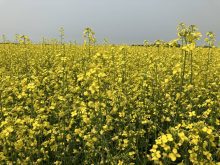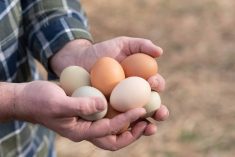It was a difficult year for many canola producers across the Prairies in 2021 due to the historic drought, which lowered yields and, in the worst cases, wiped out crops completely. Supply chain challenges compounded the difficulties farmers faced created by the global pandemic.
Jim Everson, Canola Council of Canada president, acknowledged these adversities in his opening remarks during his presentation at Canola Week 2021 in December, adding a few more, such as today’s unpredictable business climate, a beleaguered global trade environment and uneven recovery from the pandemic, which continues to be disrupted by the COVID-19 virus and related supply chain challenges. There is also the ongoing canola seed trade disruption with China and global efforts to mitigate climate change are “altering the commercial environment with taxes and regulation,” Everson says.
Read Also

Health hazards are often overlooked risks on the farm
While quite different from the dangers posed by farm machinery, hazards such as loud noise or sun exposure require the same proactive attention, the Canadian Agricultural Safety Association says.
Despite these challenges, there are several reasons canola sector stakeholders can be optimistic about the future. First, the fundamentals of global demand are “in our favour,” says Everson. Demand for healthier food products like canola oil and canola protein by a growing global middle class is strong. Demand is also increasing in new areas such as canola meal for aquaculture diets and protein for human food ingredients. One of the most important developments could be global efforts to address climate change as countries like Canada and the United States introduce renewable fuel mandates to reduce greenhouse gas emissions.
Gaining a foothold in the renewable fuel market could mean increases in demand for canola. Projections indicate by 2025 North American canola demand for biofuels could range from 2.8 million tonnes to 5.0 million tonnes in low- and high-demand scenarios, respectively. And by 2030, North American demand for biofuels could range from 4.7 million to 9.4 million tonnes in low- and high-demand scenarios, respectively (see below).

“This is a huge opportunity for our industry because canola oil is one of the best feedstocks available for renewable fuels,” says Everson.
“The Canola Council of Canada is very active in discussions with the government of Canada as work is done to finalize the Clean Fuel Regulations, which we anticipate will be in place by the end of 2022. If done properly, the standard will drive new demand for canola.
“The impact of these two factors — high demand for Canada’s sustainably produced healthy oil for food use and low-carbon-emission canola for diesel fuel — are driving investment and growth in our industry. By 2025, Canada will be able to process 50 per cent more canola seed than today, thanks to more than $2 billion in capital investment announced by our canola processors. These expansions will create a steady source of canola demand for surrounding farmers, plus good, reliable jobs for thousands of Canadians.”
Because of these new opportunities, the biggest challenge the sector faces is growing more canola to keep up with demand. “We need to focus our collective efforts on growing more canola to keep up with demand today,” says Everson. Therefore, meeting yield targets, by increasing the productivity of every canola acre or aiming to achieve average yields of 52 bushels per acre, is job No. 1.
While meeting the Canola Council of Canada’s target of 26 million tonnes by 2025, the sector must do so in a sustainable way, while contributing to the global effort to reduce greenhouse gas emissions.
To get there, farmers will need continued advancements in agronomic practices, access to new tools like higher-yielding cultivars, smart fertilizers, and canola varieties with a wide range of resistance to disease, extreme weather and pod shatter. These improvements will depend on research and innovation, says Everson.
“Climate change and the environment will be a critical lens through which research priorities and funding will be considered,” says Everson. “We cannot overstate the importance of research and innovation in driving our industry forward.”
Eighty-four per cent of on-farm emissions from canola production come from the use of nitrogen fertilizer. This fertilizer is a critical tool for farmers, who need continued access to nitrogen and other production tools. Innovation should be the objective to reduce emissions from fertilizer use and to support growers to move to more precise fertility practices, including the credit to farmers and industry for sequestering carbon through canola production, rather than reducing fertilizer emissions through regulating reductions in fertilizer use, Everson maintains.
“The real question is, how do we, as an industry, continue to provide innovative products and practices to the grower and the whole value chain that meet our goals for increased production to meet global demand while ensuring sustainability and reduced emissions? As with all big advancements in canola, investments in innovation and research will again be the answer.”
Substantial investment, including from government, will be essential to meet the world’s demands for canola oil as a healthy food, low-carbon fuel and reducing emissions from nitrogen fertilizer.
The Guelph Statement, released last November, sets out priorities and guiding principles for the next agriculture policy framework. Priorities outlined in the statement include tackling climate change and environmental protection, continued and targeted investments in science, research and innovation, to support sustainable agriculture and economic growth by creating the conditions for Canadian businesses to meet evolving challenges of the interconnected domestic and global marketplace, and more. Everson says to meet these priorities while addressing climate change will require substantial investment by governments.
“It would be a mistake to reduce funding to market access and promotions, to technology adaptation and to grower agronomic research by shifting existing resources to other challenges. To meet the challenge of climate change, governments will need to increase funding both to the five-year policy framework and through funding programs geared directly to climate change mitigation across government,” he says.
“At this critical time, we need to remind governments that canola is poised to continue to drive economic growth and that canola research is an essential investment in Canada’s economic future.”
The 2021 drought tested almost all Prairie farmers. And disruptions to trade and the supply chain have also been obstacles for farmers to overcome — and may still pose difficulties in 2022. However, the 2021 growing season aside, the future of canola production in Canada looks great.
“This is a time of significant disruption and uncertainty in the Canadian canola sector. But it’s also a time when we see great opportunity on the horizon. With continued investments, teamwork and research and innovation, we are confident we can break through the next level of productivity, and we can do it in a way that is truly sustainable and aligned with our market demands. Getting there will require the co-operation of our partners in government as both research partners and policy-makers. We’ll also need the commitment, ideas and enthusiasm of the entire canola value chain. These strengths are the lifeblood of our sector and have never been more essential than they are right now,” says Everson.
Here’s to better things in 2022 and beyond!
Kari
















